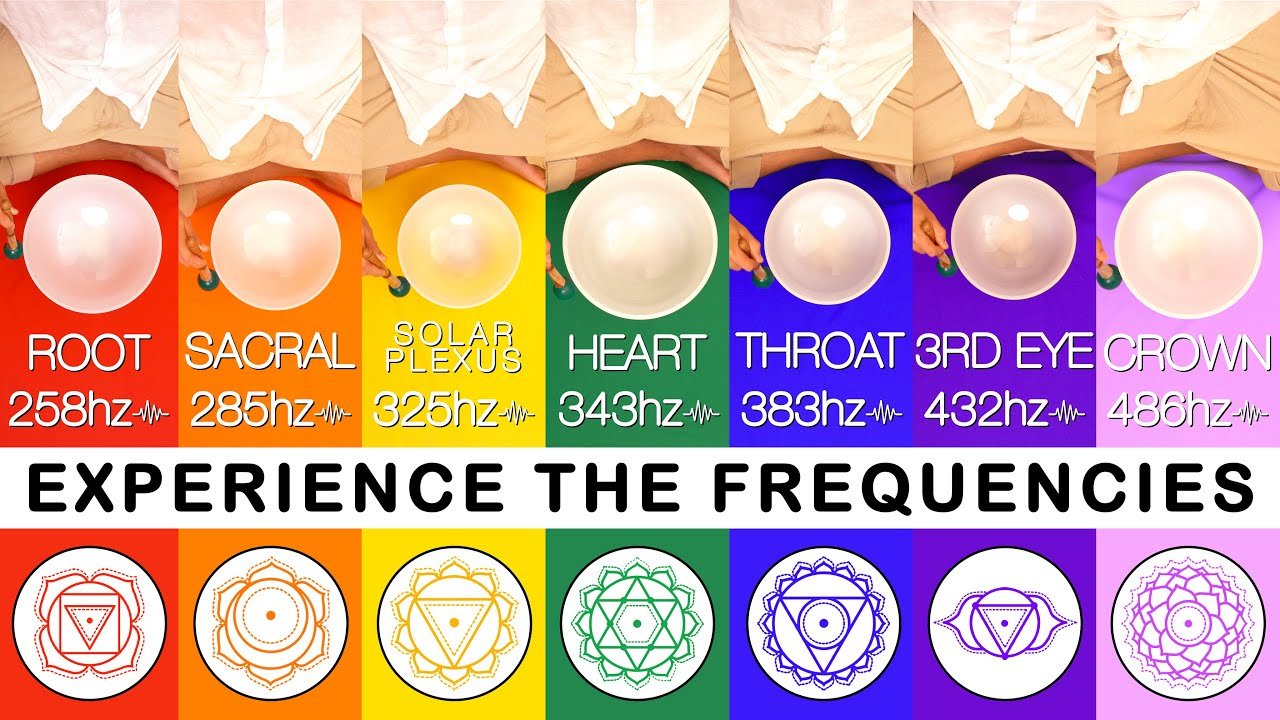The Enchanted Church Part 5
CHRISTIANS AND FREQUENCY HEALING
CHRISTIANS ARE SPENDING THOUSANDS OF DOLLARS ON CRYSTAL BOWLS AND RECEIVING FREQUENCY HEALING TREATMENTS. SHOULD CHRISTIANS SEEK HEALING FROM BUDDHA BOWLS?
Within the depths of our nation, a resurgence of witchcraft and spiritism has stealthily swept through the corridors of society, evading the discernment of the American church. Believe it or not, social media platforms have shockingly unveiled staggering statistics that capture Generation Z's and Millennials' fascination with all things witchy. For example, the hashtag #witchtok (according to 2022 analytics) garnered over 30 billion views!
In 1990 a survey by Trinity College in Connecticut estimated that were around 8,000 Wicca followers in the United States of America.
By 2008, the U.S. Census Bureau revealed a rather unexpected figure of 342,000 adherents!
In 2014, the Pew Research Center study expanded that projection even further, indicating that approximately 0.4% of Americans identified as pagan, approximately 1,324,000!!
It is now being projected that by 2050, the number of Americans practicing "other religions" outside the major faiths would triple, partly due to increased individuals switching to Wicca and pagan religions.
America is veering away from a strictly humanistic trajectory. The influence of radical atheists within the influencer scene seems to have diminished, and the idea of a purely secular world devoid of other realms and spirits is losing its grip on popular belief.
A broader perspective is taking hold due to the rise in popularity of hallucinogenics and the persuasive voices of figures like Tim Ferris and Joe Rogan.
Sociologists even have a name for it: they say that America is becoming "enchanted."
As we observe the shifting tides of belief and the increasing fascination with the mystical, we find ourselves standing at a significant crossroads in our nation's history. Regardless of our inclinations, we cannot deny that people's enduring interest in the enigmatic and spiritual shapes a new narrative. It is a testament to the inherent search within the hearts of humanity, a longing for something transcendent and divine. This longing reflects our intrinsic need for a relationship with God and points to the eternal truth that can only be found in Jesus Christ.
Bewitched
The rapid and drastic shift from science being America's favored religion to a full-blown embrace of spiritism has caused reverberations that undeniably influence and impact the church. If the Apostle Paul were to pen a letter to today's modern Christian, it might echo his sentiments in Galatians 3: "Oh, foolish Americans! Who has cast a spell on you? Who has beguiled you, preventing you from obeying the truth?"
To be bewitched signifies being ensnared or controlled by the allure of magic and sorcery. It implies a state of being enchanted, captivated, or fascinated by supernatural or mystical forces. When one is bewitched, it suggests a profound enthrallment or enchantment, as if under the influence of a spell or mystical power. Metaphorically speaking, it describes a deep infatuation or fascination that overwhelms one's thoughts, emotions, or actions. It can also imply being manipulated or deceived by someone or something. In essence, being bewitched entails being under the sway of enchantment or spellbinding influence, whether it be literal or figurative.
Frequency Therapy
One aspect of this bewitchment that is permeating the Christian church is the integration of frequency therapy as a means of healing for the body and soul. This integration attempts to blend Christianity and science as a foundation for how frequencies created by singing bowls can be a significant source for healing.
However, it is crucial to acknowledge that the origins of this healing practice do not stem from Christianity, Christians, or even our Jewish heritage. Instead, they trace back to Eastern spiritism, and ancient occult modalities.
Singing Bowls
Singing bowls encompass various shapes, sizes, and materials, each claiming to offer unique qualities and therapeutic benefits. In this exploration, I'll show you multiple examples of bowls being utilized in frequency therapy, focusing on their claimed resonating properties and the healing energy and spiritual frequencies they generate.
Tibetan Bowls
These miniature metal bowls allegedly emit two distinct notes when struck. Curiously, it is believed that producing these notes by striking the rim rather than the bowl's bottom yields different frequencies. Proponents claim that these varying frequencies offer diverse healing modalities.
Crystal Bowls
Another category of interest is the crystal bowls, which exhibit a variety of compositions depending on the infused gems within their glass structure. Most commonly, crystal quartz finds its way into these bowls. Advocates of bowl therapy assert that crystal quartz bowls possess the unique ability to restore energy in a targeted manner. For instance, those seeking a sense of purification might turn to selenite bowls, while individuals experiencing loneliness and isolation might opt for bowls infused with morganite, as these purportedly generate vibrations that evoke feelings of love.
Himalayan Bowls
Grouping all these resonating bowls, they can be collectively referred to as Buddha bowls, owing to their historical roots in Tibet, Nepal, and India. Dating centuries, these bowls have played a central role in spiritual practices, meditation, and healing rituals.
Tracing their origins to the Himalayan region around 2,500 years ago, they earned the famous moniker "Himalayan bowls." Primarily utilized by Buddhist monks during meditation and ceremonies, these bowls were believed to induce resonance and vibrations that facilitated the opening of the mind, body, and spirit, leading adherents into trancelike spiritual states.
Hey, at least it's not morphine!
The intention behind this article is not to express concern over Buddhist monks utilizing bowls for spiritual purposes but to shed light on a growing trend among Christians. It has come to my attention that many Christians, including many individuals I hold dear, have begun incorporating bowls into their yoga, meditation, and self-healing routines. Curiously, they argue that these practices can be reconciled with their faith. However, what raises concern is the lack of personal research conducted by these Christians regarding the origins of these spiritual practices. In fact, many deny these practices' inherently spiritual nature altogether. Instead, they rely on podcasts or ministers who market bowl therapy as a legitimate alternative medicine, leading them to simplify their perspective into a single phrase: "Hey, at least it's not morphine."
Marketing Bowl Technology
Upon delving into the realm of bowl healing, a consistent pattern emerges in the marketing strategies employed. A common tactic is invoking the words "ancient" and "healing" to confer credibility upon these spiritual practices or forms of healing. Using these terms seems to create a perception of legitimacy, as the belief persists that anything "ancient" must inherently be "valid."
Another claim often encountered is the assertion that bowl healing predates the time of Christ. This assertion is rather amusing, as it comes with an underlying assumption: the implication that since bowl healing predates Christ, it holds more trustworthiness and authority than Jesus Himself.
Well, congratulations to the marketers of bowl healing! You have succeeded in making your point. By emphasizing the practice's ancient origins, you have convinced some that it is not only legitimate but also potentially more powerful than healing in the name of Jesus or through prayer from ministry team members in a church or healing room.
I have even come across the audacious claim that the tremendous healing secrets discovered by previous civilizations render the crucifixion and the work of Jesus on the cross unnecessary.
The Role of Singing Bowls in Buddhist Practices
It is worth noting that while Buddhist monks were indeed among the early adopters of using bowls for purposes other than eating cereal, their original intent did not involve healing.
These bowls were instruments capable of producing sacred vibrations, believed to facilitate portals opening to the spirit realm. Through these vibrations, the energy portals within the human body were thought to be activated, infusing them with spiritual light. This process was associated with perceived healing, mindfulness, and a profound sense of peace, resulting from purifying these energetic centers within the body.
Consequently, a connection can be drawn between using singing bowls to create frequencies that aim to open and illuminate the chakras or energetic portals within the body.
Exploring Bowls, Energy, and Chakras
The concept of chakras finds its roots in ancient Indian spiritual mysticism, particularly within Hinduism and Buddhism. These religions propose that chakras are spiritual energy centers within the human body. The term "chakra" itself, derived from Sanskrit, translates to "wheel" or "disk," symbolizing the notion of these energy centers spinning or rotating.
In some Christian bowl therapy practices, these principles are borrowed, and individuals are taught that their bodies contain energetic portals functioning as spiritual doorways or access points. They are led to believe that "energy" or "light" flows through these portals, and therefore, they unknowingly open themselves up to these influences.
They are often told that frequency is synonymous with light, and since all light is from God, the perceived healing is attributed to God entering their being.
At first glance, this may seem innocuous, but the truth is that as people open themselves up, they become susceptible to counterfeit light. What enters is not mere energy but rather, a spiritual entity.
“…as people open themselves up, they become susceptible to counterfeit light. What enters is not mere energy but rather, a spiritual entity.”
Remember that portals serve as entry points for spiritual beings, and such entities naturally seek to inhabit humans. Consequently, individuals unwittingly become hosts for these spirits, willingly or not.
If one is willing to accommodate a spirit, a transaction takes place. The offer is to relinquish one's body in exchange for the relief of pain, sadness, or anxiety. However, this trade is transient, as the spirits rarely fulfill their end of the bargain. Instead, individuals find themselves entangled in a web of deceit.
Bowl enthusiasts assert that the human body comprises gateways that connect different realms. The feelings of peace, interconnectedness, and mindfulness experienced in the short term serve as a form of payment, enabling the spirit realm to open and exploit the individual's body as a host.
The Chakra System
The concept of chakras revolves around seven main energy centers aligned along the spine, extending from the base to the crown of the head. It is important to note that some individuals, even self-proclaimed "Christian ministers," have made claims about the spirit man being located at the base of the spine, asserting that this insight was divinely revealed to them. However, such assertions are borrowed from Eastern mysticism and occult practices.
Each chakra is believed to be associated with specific qualities and functions, encompassing physical, emotional, mental, and spiritual aspects. These energy centers are interconnected and contribute to an individual's well-being and inner harmony.
Here is a brief overview of the seven main chakras and their general associations:
1. Root Chakra (Muladhara): Situated at the base of the spine, it is commonly associated with stability, grounding, and meeting basic survival needs.
2. Sacral Chakra (Svadhishthana): Found in the lower abdomen, it is typically linked to emotions, creativity, sexuality, and interpersonal relationships.
3. Solar Plexus Chakra (Manipura): Located in the upper abdomen, it is often associated with personal power, self-confidence, and the expression of will.
4. Heart Chakra (Anahata): Positioned in the center of the chest, it is commonly associated with love, compassion, forgiveness, and emotional healing.
5. Throat Chakra (Vishuddha): Found in the throat region, it is typically connected to communication, self-expression, and the ability to speak one's truth.
6. Third Eye Chakra (Ajna): Situated in the middle of the forehead, it is often associated with intuition, perception, and expanded spiritual awareness.
7. Crown Chakra (Sahasrara): Located at the top of the head, it is commonly associated with spiritual connection, enlightenment, and the exploration of higher consciousness.
Supporters of bowl therapy often claim that the selection of bowls is related to targeting a specific chakra on a given day, aligning their choice with the associated qualities and functions of that particular energy center.
Examining Implied Parallels
Many individuals are now drawing parallels between the chakra system and Christianity.
Here are a few examples; I do not believe or endorse these parallels. I present them to illustrate the potential for deceptive mixtures:
1. Divine Energy:
One argument suggests that the Holy Spirit, representing God's divine energy within individuals, can be likened to the concept of chakras. They propose that the Holy Spirit's transformative energy aligns with and activates the chakras, bringing about spiritual growth. However, it is crucial to recognize that the Holy Spirit is not a mere energy force but the third person of the Holy Trinity.
2. Body as the Temple:
The belief that Christians view their bodies as temples of the Holy Spirit aligns with the idea of chakras as spiritual energy centers within the body. Both perspectives acknowledge the sacredness of the body. However, it is vital to discern their understanding and significance differences.
3. Spiritual Growth and Transformation:
Christianity emphasizes the process of sanctification, which involves the purification and renewal of the heart, mind, and soul. Some may argue that the chakra system provides a framework for supporting this process. While personal growth and transformation are common themes, the underlying beliefs, and practices differ significantly between the two.
4. Virtues and Qualities:
Associating the virtues and qualities of each chakra with Christian virtues is another argument. For example, the heart chakra's focus on love and compassion may align with Christian teachings on love and kindness. However, it is crucial to distinguish the source and foundation of these virtues.
5. Prayer and Meditation:
Christianity places importance on prayer and meditation as avenues for spiritual connection. Similarly, practices involving chakras, such as meditation and mindfulness, are complementary. However, these practices' underlying intentions, methods, and spiritual frameworks differ radically.
The Challenge of Merging Frequency Healing and Christian Worship
In Scripture, various musical instruments such as cymbals, bells, and tambourines are mentioned in the context of worship. These instruments are utilized to direct praise, honor, and worship towards Yahweh, the Creator, and sustainer of all life.
Worship involves created beings offering their adoration to the Creator using created things. However, blending frequency healing, singing bowl therapy, and other New Age or alternative spiritual practices into one's Christian journey can present several problematic aspects.
Worship and the Sovereignty of God
For Christians, worship is primarily centered on God and His absolute sovereignty. When frequency healing, singing bowl therapy, and other external practices become intertwined with worship, the focus can shift from honoring and worshiping the one true God to seeking healing or spiritual experiences through external means.
This diversion can lead to a distortion of true worship, wherein God's power and authority are replaced with a reliance on specific frequencies or vibrations.
Consequently, it becomes a path that inclines towards self-worship, wherein pursuing a "divine self" takes precedence over reverence for God.
As believers, we must clearly understand the purpose and focus of worship, ensuring that God remains the central figure and His sovereignty is upheld.
Divine Self
As believers, we firmly reject the idea that, merely because we carry the presence of God and serve as a temple of the Holy Spirit, we possess or share a divine essence.
Our purpose as Christians is not to aspire to godhood.
While this may be a common pursuit in many Eastern religions, our journey is distinct. Instead of seeking to awaken to our inherent divinity, we focus on recognizing our dependence on God and embracing the transformative power of His grace. Our goal is to grow in our relationship with Him, aligning our lives with His will and reflecting His love and character to the world around us.
Orin, a nonphysical spirit guide that is contacted through conscious channeling, has this to say about the revelation of the divine Self.
"…your Divine Self is the Self that exists at an even higher level than your soul. It is the Divine essence of your being, the source of all light and life within you. Your soul is closer to your personality and is an intermediary between you and your Divine Self until you can directly experience and realize the Divine Self as who you are."
"Your Divine Self is always trying to reach you, to send you the power, illumination, love, and wisdom to draw higher forms, thoughts, feelings, and situations into your life. Your Divine Self is wise; it knows all and always shows you an easier, better, more joyful way to live."
Yes, we are created in the image of God and have inherent worth and dignity. However, the concept of a "Divine Self" or God-self shifts the responsibility from developing a personal relationship with God through Jesus Christ to simply getting to know, love, and trust your inner Self.
Under this demonic theology, one believes that they have been awakened to their divine essence. Simply stated, they believe that they are God.
Salvation and transformation do not come from discovering your God-self. It comes through faith in Jesus, who is the Son of God, our High Preist, and the mediator between humanity and God. Through this relationship with God, through Christ, Christians discover who they are in Him.
Rather than striving to realize a separate Divine Self, Christians seek to align their lives with God's will, to be transformed by the Holy Spirit, and to live by the teachings of Jesus. They believe that God's wisdom, power, and love are accessible through this relationship and that God guides and directs their lives through His Word, the Bible, and the indwelling presence of the Holy Spirit.
Union Doesn't Make You God
Union in Christ does not elevate us to the status of being God. While some argue that being in Christ and having Him within us should allow us to receive worship, this is not the case. Our union with Christ enables us to become godly and reflect His divine attributes, but it does not grant us the authority to violate Scripture.
In Matthew 4:10, we are reminded to worship the Lord our God and serve Him alone. This commandment establishes that worship should be directed solely toward God, acknowledging His unique and supreme position.
Additionally, in Romans 12:3, the Apostle Paul advises us not to think of ourselves more highly than we ought to but to have a balanced and humble perspective. We are called to exercise sober judgment and recognize that our gifts or abilities are given to us by God's grace and should be used for His glory rather than for self-exaltation.
Therefore, while our union with Christ brings us into a godly and transformative relationship, it does not grant us the authority or status of divinity. Instead, it calls us to worship and serve God alone, humbly acknowledging His supremacy and relying on His grace and guidance.
Divine healing and faith
Divine healing and faith are intricately connected according to biblical teachings. Just as salvation is received through faith in Jesus Christ, divine healing is obtained through faith in Him. While various alternative healing practices may claim to offer physical or spiritual healing, it is crucial to be cautious about merging them with the Christian faith, as doing so can potentially undermine our trust in God's ability to heal and replace it with reliance on methods or techniques.
James 5:15 states that the prayer of faith can bring salvation to the sick, with the assurance that the Lord will raise them up and forgive their sins.
Suppose we find that operating in the authority and name of Jesus could be more effective, and we begin to incorporate substances, sounds, movements, or unique phrase structures. In that case, it is crucial to recognize that once we discover something that seems to work, our attention may shift toward the method rather than Jesus. It is essential to understand that when it comes to supernatural healing, Jesus is enough.
If, under the leading of the Holy Spirit, we are prompted to perform an unconventional action like spitting in mud and applying it to a blind person's eyes, obedience to that specific instruction is paramount. However, it is crucial not to elevate the substance or action as the healing source. Our obedience, guided by the Holy Spirit, brings about healing, not the physical elements involved.
Therefore, we should remember that supernatural healing ultimately rests in Jesus alone. We must avoid attributing the healing to additional elements or practices and refrain from commercializing or glorifying them. Instead, we should focus on Jesus and His power, trusting in His guidance and obeying His leadership.
Spiritual Deception
In conclusion, it is crucial to acknowledge the potential dangers of incorporating singing bowl therapy into Christian practice. The merging of frequency healing and mystical modalities can open doors to the spirit world, exposing believers to deception and influences that directly contradict the teachings of the Bible. As devoted followers of Jesus, we are responsible for remaining steadfast and unwavering, protecting ourselves from any practices that compromise the truth and power of God's Word.
The Apostle Paul's admonition in Colossians 2:8 holds significant relevance in this context. We must not allow ourselves to be captivated by the empty deceit of human tradition or by the elemental spirits of the world. Our allegiance belongs solely to the will of the Father, the centrality of Christ, and the unadulterated power of the Holy Spirit. Our commitment should be relentless and firmly rooted in the Gospel's good news and the transformative power of Christ's resurrection.
Let us not be enticed by the allure of spiritual practices that divert us from the truth. We should build our trust upon Jesus Christ, the unshakable foundation, rather than on the shifting sands of Eastern mystical ideologies. We must reject any integration that dilutes the purity of the Gospel and jeopardizes our intimate relationship with God. By remaining steadfast in our devotion to God's Word and discerning our spiritual practices, we guard ourselves against the deceptions that may lead us astray.


















